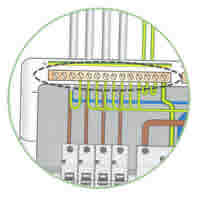A suitable Main Earthing Terminal (MET) must be provided for every installation.

Snags commonly found at the main earthing terminal of an installation include:
- An insufficient number of terminals being available
- Not all the terminals being suitable for the different-sized protective conductors that are to be, or have been, connected
- Terminals not being suitably marked or arranged for identification
- The arrangement not being protected from external influences such as water corrosion, damage, or vandalism
Solution
BS 7671 does not stipulate a particular form of MET, but leaves this to be dictated by the needs of the particular installation, subject to certain requirements being met. Hence METs take a variety of forms, ranging from simple to complex, either within or separate from the main switchgear.
The MET must be selected to take account of the following requirements:
- Regulation 9 of the Electricity at Work Regulations requires that 'if a circuit conductor is connected to earth or to any other reference point, nothing which might reasonably be expected to give rise to danger by breaking the electrical continuity or introducing high impedance shall be placed in that conductor unless suitable precautions are taken to prevent that danger', and
- sufficient terminals are to be provided to accommodate separately the earthing conductor and all other conductors referred to in Regulation 542.4.1, not forgetting future additions that may reasonably be expected.
Also sufficient terminals are required for the separate connection of any duplicate protective conductors required by Section 543.7 for circuits supplying equipment having high protective conductor currents, and - the terminals are to be suitable for the conductor material, number and shape of the wires, cross-sectional area and number of conductors to be connected together (for example for ring final circuits), and
- the effects of temperature and vibration are to be taken into account as required by Regulation 526.2, and
- the terminals are to be suitably arranged or marked so that the conductors connected to them can be identified for inspection, testing, repair or alteration of the installation as required by Regulation 514.1.2 (unless the conductors are identifiable by other means, such as markers attached to them), and
- a means for disconnecting the earthing conductor for testing is to be provided as required by Regulation 542.4.2, and
- where necessary, the MET and its connections need to be protected (e.g. by an enclosure) against vandalism, unauthorised interference or other external influences such as damp or dust, as required by Section 522, and
- where the MET is separate from the main switchgear, a permanent label, with the words 'SAFETY ELECTRICAL CONNECTION - DO NOT REMOVE', is to be fixed in a visible position at or near the MET, as required by Regulation 514.13.1.
Regulation 514.1.2
As far as is reasonably practicable, wiring shall be so arranged or marked that it can be identified for inspection, testing, repair or alteration of the installation.
Regulation 514.13.1 (part of)
A permanent label to BS 951 with the words "Safety Electrical Connection - Do Not Remove" shall be permanently fixed in a visible position or near
(iii) the main terminal, where separate from main switchgear
Regulation 542.4.1
In every installation a main earthing terminal shall be provided to connect the following earthing conductor:
(i) The circuit protective conductors
(ii) The protective bonding conductors
(iii) Functional earthing conductors (if required)
(iv) Lighting protection system bonding conductor (if any)
Regulation 542.4.2
To facilitate measurement of the resistance of the earthing arrangements, means shall be provided in an accessible position for disconnecting the earthing conductor. Such means may conveniently be combined with the main earthing terminal or bar. Any joint shall be capable of disconnection only by means of a tool.
